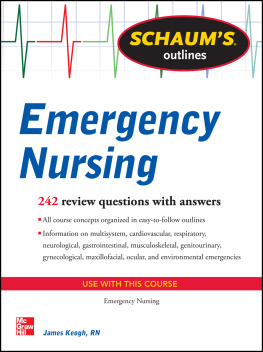
SCHAUMS
outlines
Emergency Nursing
SCHAUMS
outlines
Emergency Nursing
James Keogh, RN


James Keogh, RN-BC, AAS, MBA, is a registered nurse and has written Schaum's Outline of Pharmacology, Schaum's Outline of Nursing Laboratory and Diagnostic Tests, Schaum's Outline of Medical-Surgical Nursing, and Schaum's Outline of Medical Charting and coauthored Schaum's Outline of ECG Interpretation. His books can be found in leading university libraries including Yale University School of Medicine, University of Pennsylvania Biomedical Library, Columbia University, Brown University, University of Medicine and Dentistry of New Jersey, Cambridge University, and Oxford University. He is a former member of the faculty of Columbia University and a member of the faculty of New York University.
Copyright 2013 by The McGraw-Hill Companies, Inc. All rights reserved. Except as permitted under the United States Copyright Act of 1976, no part of this publication may be reproduced or distributed in any form or by any means, or stored in a database or retrieval system, without the prior written permission of the publisher.
ISBN 978-0-07-178981-3
MHID 0-07-178981-2
The material in this eBook also appears in the print version of this title: ISBN 978-0-07-178980-6, MHID 0-07-178980-4.
All trademarks are trademarks of their respective owners. Rather than put a trademark symbol after every occurrence of a trademarked name, we use names in an editorial fashion only, and to the benefit of the trademark owner, with no intention of infringement of the trademark. Where such designations appear in this book, they have been printed with initial caps.
McGraw-Hill eBooks are available at special quantity discounts to use as premiums and sales promotions, or for use in corporate training programs. To contact a representative please e-mail us at .
The information contained in this book is intended to provide helpful and informative material on the subject addressed. It is not intended to serve as a replacement for professional medical advice. Any use of the information in this book is at the reader's discretion. The author and the publisher specifically disclaim any and all liability arising directly or indirectly from the use or application of any information contained in this book. A healthcare professional should be consulted regarding your specific situation.
McGraw-Hill, the McGraw-Hill Publishing logo, Schaum's, and related trade dress are trademarks or registered trademarks of The McGraw-Hill Companies and/or its affiliates in the United States and other countries and may not be used without written permission. All other trademarks are the property of their respective owners. The McGraw-Hill Companies is not associated with any product or vendor mentioned in this book.
Interior artwork on pages 8, 9, 101, 107, 115, 185, 324 by S4Carlisle Publishing Services
TERMS OF USE
This is a copyrighted work and The McGraw-Hill Companies, Inc. (McGraw-Hill) and its licensors reserve all rights in and to the work. Use of this work is subject to these terms. Except as permitted under the Copyright Act of 1976 and the right to store and retrieve one copy of the work, you may not decompile, disassemble, reverse engineer, reproduce, modify, create derivative works based upon, transmit, distribute, disseminate, sell, publish or sublicense the work or any part of it without McGraw-Hill's prior consent. You may use the work for your own noncommercial and personal use; any other use of the work is strictly prohibited. Your right to use the work may be terminated if you fail to comply with these terms.
THE WORK IS PROVIDED AS IS. McGRAW-HILL AND ITS LICENSORS MAKE NO GUARANTEES OR WARRANTIES AS TO THE ACCURACY, ADEQUACY OR COMPLETENESS OF OR RESULTS TO BE OBTAINED FROM USING THE WORK, INCLUDING ANY INFORMATION THAT CAN BE ACCESSED THROUGH THE WORK VIA HYPERLINK OR OTHERWISE, AND EXPRESSLY DISCLAIM ANY WARRANTY, EXPRESS OR IMPLIED, INCLUDING BUT NOT LIMITED TO IMPLIED WARRANTIES OF MERCHANTABILITY OR FITNESS FOR A PARTICULAR PURPOSE. McGraw-Hill and its licensors do not warrant or guarantee that the functions contained in the work will meet your requirements or that its operation will be uninterrupted or error free. Neither McGraw-Hill nor its licensors shall be liable to you or anyone else for any inaccuracy, error or omission, regardless of cause, in the work or for any damages resulting therefrom. McGraw-Hill has no responsibility for the content of any information accessed through the work. Under no circumstances shall McGraw-Hill and/or its licensors be liable for any indirect, incidental, special, punitive, consequential or similar damages that result from the use of or inability to use the work, even if any of them has been advised of the possibility of such damages. This limitation of liability shall apply to any claim or cause whatsoever whether such claim or cause arises in contract, tort or otherwise.
This book is dedicated to Anne, Sandy, Joanne, Amber-Leigh Christine, Shawn, Eric, and Amy, without whose help and support this book couldnt have been written.
Contents
- Triage is the systematic process of prioritizing patients based on patient acuity when confronted with limited medical resources. The goal is to allocate medical resources that will result in a positive difference in the patients outcome.
- Triage was developed by French physicians during World War I to organize treatment of soldiers on the battlefield.
- Triage is a continuous process because the patients condition can change during interventions to stabilize the patient. In a trauma, a patients injuries may appear minor at first but may become more serious following the initial triage assessment. Therefore, patients must be continuously evaluated until stabilized.
- There are two models for triage:
- Primitive: the practitioner prioritizes patients based on the practitioners best guess at the time of assessment. This method is used in the earliest stage of an incident and when there are more patients than can be practically assessed by the practitioner.
- Modern: the practitioner prioritizes patients based on physiological and scientific assessment. This method is used in the later stage of an incident and when the ratio of patients to practitioner is relatively low.
- There are two methods of triage:
- Primary: primary triage requires the practitioner to detect and treat life-threatening conditions.
- Secondary: secondary triage requires the practitioner to detect and treat non-life-threatening conditions.
- The practitioner performs a primary triage assessment when the patient is first presented to him or her. A commonly used primary triage model is Simple Triage and Rapid Treatment (START), which was developed at Hoag Hospital in Newport Beach, California. The results of the primary triage assessment enable the practitioner to assign the patient to one of four treatment categories.
- Minor: these are patients who are likely to live regardless of the care they receive. Sometimes these patients are referred to as the walking wounded.
Next page






